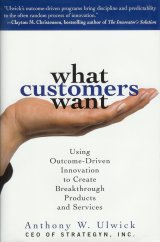
When I talk with people about my business, I often use a book I recently read as a basis for explaining what I do. That book is What Customers Want by Anthony Ulwick. Since reading it, the book has become an indispensable resource in my business and now has a permanent place in my library.
Ulwick's premise is that "voice of the customer" is the wrong way to identify opportunities for innovation. This "voice of the customer" often is interpreted as solutions, specifications, needs, and benefits. The feedback misleads businesses into creating products that hold little or no value. What businesses should do is take an outcome-driven approach to build innovative solution.
An outcome-driven approach is based on three principles:
- The job(s) that need to be done
- The desired outcomes (metrics)
- The constraints or obstacles customers wish to overcome
So, when I speak with folks about my business and how I help companies implement technology solutions into their business processes, I explain to them that building an IT solution to improve business performance is more than just gathering a wish list of features and functions from end-users along with business goals and objectives from managers and executives. To create a true user-centered IT solution, you need to understand the job that is being done, what the results should be after using the solution, and what barriers to performance the end-users and the business wish to overcome. In short, Ulwick's framework which I use for gathering inputs is the best way to give your end-users what they really want.

No comments:
Post a Comment